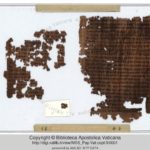| Artefact ID | 58 |
| TM ID | TM 107766 |
| Findspot (DEChriM ID) | 24 (Dišnā) | Class | Textual |
| Material | Papyrus |
| Writing medium | Codex |
| Text content | Literary |
| Language | Coptic |
| Description | Papyrus codex containing the text of the Minor Prophets in Coptic (Early Bohairic dialect - B4; according to Rodolphe Kasser, B74). The codex originally contained 73 folios, of which 72 are extant, in different states of preservation. The text is organised in a single column, with the average size of the column 16.5 x 10.5 cm. The original size of the folios was 20 x 14.5 cm. Interlinear notes feature on several leaves. Although variable, the module of the letters of these interlinear additions tends to be smaller (and is often much more reduced) than that of the letters in the body of the text. The calamus is also significantly thinner. The hand responsible for these annotations is clearly different than that of the main scribe of the codex (djandja with longer and curved upper endings; epsilon with more prominent and angular left curve; larger upsilon; etc.). A number of characteristics define the palaeographical profile of Pap. Vat. copt. 9, among which: the unique shape of the Bohairic-specific letter 4; very low (hardly descending bellow the lower base line) and narrow u drawn in two movements; low and compacted + with the haste tending to scarcely descend bellow the base line (although there is notable variety in the sizes and ductus of +); a with particularly angular belly and drawn in two movements; slender b drawn in two movements; large and round o, raising all the way to the upper line; etc. Parepigraphic signs include: superlinear stroke over nomina sacra; djinkim represented as a dot (centred above n); thin superlinear stroke (above tautosyllabic n and m in coda position, but also where the dot-djinkim occurs [e.g. p. 5, 15 and 17, where both dot-djinkim and superlinear stroke are employed interchangeably – examples are abundant]); diaeresis (above i). Rare obelisms are represented by a non dotted diple (e.g. p. 15 and 19 as marginalia, but also inside the text, on p. 5, for instance, as text break).
|
| Selection criteria | Literary genre (Biblical), Coptic language |
| Date from | 300 |
| Date to | 399 |
| Dating criteria | Palaeography; proportions. |
| Absolute/relative date | Relative date |
| Archaeological context | Unknown. The codex was acquired by the Vatican Library in October 1980 and is generally considered part of the Bodmer Papyri. However, its connection with this collection as well as with Dišna, to which James Robinson associated this group of manuscripts, is doubtful. Pap. Vat. copt. 9 was very likely produced in the Nile Delta, probably in its southern part, as suggested by Bosson 2012: 76, following Kasser 2006: 406-407, who called the dialectal variety of the codex "sud-bohaïrique". |
| Accession number | Rome, Vatican, Biblioteca Apostolica Vaticana, Pap. Vat. copt. 9 |
ARTEFACT IDENTIFIERS
Additional Bibliography
• Albrecht, F., and M. Rosenau. 2012 "Zum Textwert des Papyrus Vaticanus Copticus 9." Göttinger Miszellen 234: 21-32.
• Bosson, N. 2012. "Le Papyrus Vatican Copte 9 des Petits Prophètes." In Coptic Treasures from the Vatican Library. A Selection of Coptic, Copto-Arabic and Aethiopic Manuscripts. Papers Collected on the Occasion of the Tenth International Congress of Coptic Studies (Rome, September 17th-22nd, 2012), edited by P. Buzi and D.V. Proverbio. Città del Vaticano, 73-84.
• Bosson, N. 2014. "Synopse des témoins coptes de Jonas." Journal of Coptic Studies 16: 1-46.
• Feder, F. 2003. "Der Papyrus Vatican Copto 9 und die bohairische Version der Prophetenbücher." Hallesche Beiträge zur Orientwissenshaft 35: 113-131.
• Fournet, J.-L. 2015. "Anatomie d'une bibliothèque de l'Antiquité tardive: l'inventaire, le faciès et la provenance de la 'Bibliothèque Bodmer'." Adamantius 21: 8-40.
• Kasser, Rodolphe. 1992. "Le Pap. Vat. Copto 9, codex des Petits Prophètes (note préliminaire sur la variété subdialectale B74 de ce témoin "bohaïrique ancien", IVe s.)." In Actes du IVe Congrès Copte, Louvain-la-Neuve, 5-10 septembre 1988, II. Publications de l'institut orientaliste de Louvain, 64-73.
• Kasser, Rodolphe. 2006. "KAT’ASPE ASPE. Constellations d’idiomes coptes plus ou moins bien connus et scientifiquement reçus, aperçus, pressentis, enregistrés en une terminologie jugée utile, scintillant dans le firmament égyptien à l’aube de notre troisième millénaire." In Coptica – Gnostica – Manichaica. Mélanges offerts à Wolf-Peter Funk, Bibliothèque copte de Nag Hammadi, Section “Études” 7, edited by L. Painchaud and P.-H. Poirier. Québec, Louvain, Paris: Presses de l’Université Laval, Peeters, 389-492.
• Kasser, Rodolphe, H. Quecke, and N. Bosson. 1992. "Le second chapitre d'Aggée en bohaïrique B74." Orientalia 61: 169-207.


 Json data
Json data




